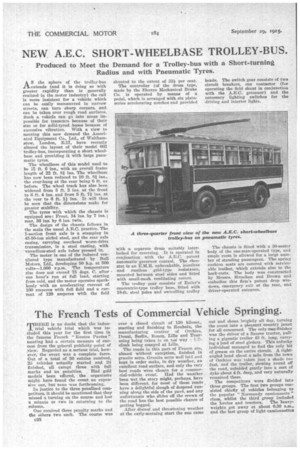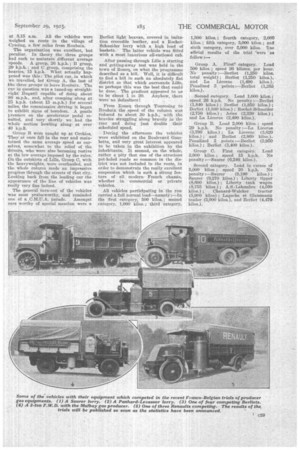The French Tests of Commercial Vehicle Springing.
Page 12

Page 13

If you've noticed an error in this article please click here to report it so we can fix it.
THERE is no doubt that the industrial vehicle trial which was included this year for the first time in the famous French "Routes Payees" meeting had a certain measure of success from the geheral publicity point of view. Regarded as a serious trial, however, the event was a complete farce. Out of a total of 50 entries received, 25 vehicles actually started ana 24 finished, all except three with full
marks and no penalties. Had gold medals been offered, the organizers might have found the event an expensive one, but none was forthcoming.
In justice to the three penalized competitors, it should be mentioned that they missed a turning on the course and lost a minute or two in returning to the column.
One received three penalty marks and the others two each. The course was 028
over a closed circuit of 120 kiloms., starting and finishing in Roubaix, the manufacturing centres of Orehies, Douai' Seem, Roncq, Lille and Tourcoing being taken in on tae way
Ullclimb being essayed at Lille.
The roads in this part of France are, almost without exception, finished in granite setts. Granite setts well laid and kept in order make, in dry weather, an excellent road surface, and only the very best roads were chosen for a comeliercial-vehiele event. Had the weather been wet the story might, perhaps, have been different, for most of these roads have a delightful slough of despond running along the side of the pave, and any unfortunate who slides off the crown of the road has the best possible chance of getting bogged.
After dismal and threatening weather at the early-morning start the sun came
out and shone brightly all day, turning the event into a pleasant country jaunt for all concerned. The only non-finisher was the driver of a Sourer tractor, pulling a gigantic trailer 43 ft. long, carrying a load of steel girders. This unlucky individual managed to find the only bit of grease on the entire circuit. A rightangled bend about a mile from the town of Orchies was taken just a shade too fast, and the trailer, [gloving round off the road, subsided gently into a sort of dyke about 4 ft. deep, and very naturally remained there.
The competitors were divided into three groups. The first two groups consisted chiefly of vehicles belonging to the popular "Normandy camionnette " class, whilst the third group included
the lorries and tractors. The 'heavyweights got away at about 6.30 a.m., and the last group of light camionnettes
at 8.15 a.m. All the vehicles were weighed en route in the village of Cysoiug-,, a few miles from Roubaix.
The organization was excellent, but peculiar. In theory the three groups had each to maintain different average speeds. A group, 26 k.p.h.; B group, 20 k.p.h.; and C group, comprising the heavies, 15 k.p.h. What actually hapPened was this: The pilot car, in which we travelled, led Group A, the last of the three groups to leave Roubaix. The ear in question was a tuned-up straighteight Bugatti capable of doing about 80 m.p.h., and, after creeping along at 25 k.p.h. (about 15 m.p.h.) for several miles, the comtuissaire driving it began to exhibit signs of boredom. A gentle pressure on the accelerator pedal resulted, and very shortly we had the whole section bowling along at over 110 k.p.lt.
Group B were caught up at Orchies, They at once fell in the rear and maintained the same average speed as ourselves, somewhat to the relief of the drivers, who were also becoming restive at the low average imposed by the rules. On the outskirts of Lille, Group C, with the heavyweights, were overhauled, and the whole column made an impressive progress through the streets of that city. Looking back from the leading car the appearance of the line of vehicles was really very fine indeed.
The general turn-out of the vehicles was most praiseworthy, and reminded one of a .C.M.U.A. parade. Amongst cars worthy of special mention were a Berliet light boxvan, covered in imitation crocodile leather, and a RochetSchneider lorry with a high load of baskets. The latter vehicle was fitted with a most luxurious all-enclosed cab.
After passing through Lille a starting and getting-away test was held in the town of Roncq, on what the programme described as a hill. Well, it is difficult to find a hill in such an absolutely flat district as that which surrounds Lille, so perhaps this was the best that could be done. The gradient appeared to us to be about 1 in 20. Anyhow, there were no defaulters I
From Roncq through Tourcoing to Roubaix the speed of the column was reduced to about 30 k.p.h., with the heavies struggling along bravely in the rear • and doing just double their scheduled speed.
During the afternoon the vehicles were exhibited on the Boulevard Gambetta, and very great interest appeared to be taken in the exhibition by the inhabitants. It seemed, on the whole, rather a pity that one of the atrocious pot-holed roads so common in the district was not included in the route, in order to demonstrate the really excellent suspension which is such a strong feature of all modern French chassis, whether in commercial or private vehicles.
All vehicles participating in the run carried a full normal load-namely :-In the first category, 500 kilos.; second category, 1,000 kilos.; third category,
1,500 kilos.; fourth category, 2,000 kilos.; fifth category, 3,000 kilos.; and sixth category, over 3,000 kilos. The official results of the trial 'were as follow -.
Group A. First!' category. Load 500 kilos. ; speed 26 kiloras. per hour. No penalty :-Berliet (1,250 kilos. total weight) ; Berliet (1,250 kilos.), and La Licorne (1,490 kilos.). Penalized 3 points :-Berliet (1,285 kilos.).
Second category. Load 1,000 kilos.; speed 26 k.p.h. No penalty :-Berliet (1,840 kilos.) ; Berliet (1,850 kilos.) ; Berliet (1,880 kilos.) ; Rochet-Schneider (2,750 kilos.) ; Aries (2,330 kilos.) ; and La Licorne (2,490 kilos.).
Group B. Load 2,000 kilos. ; speed 20 k.p.h. No penalty :-La Licorne (3,790 kilos.) ; La Licorne (3,820 kilos.) ; and Berliet (2,860 kilos.). Penalized 2 points :-Berliet (2,950 kilos.) ; Berliet (3,400 kilos.).
Group C. First categeiy. Load 8,000 kilos.; speed 15 k.p.h. No penalty :-Saurer (6,240 kilos.).
Second category. Load in excess of
3,000 kilos. ; speed 20 k.p.h. No
penalty :-Saurer (9,190 kilos.) ; Salyer (9,270 kilos.) ; Liberty tipper (8,600 kilos.) ; Liberty tank wagon (8,755 kilos.) ; A.S.-Leherabre (4,500 kilos.) ; Clienard-Walcker tractor (5,900 kilos) ; Lagache et Glaszmann trailer (5,900 kilos.), and Berliet (4,470 kilos.).






























